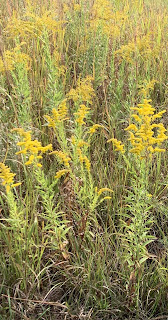Friends, ProfessorRoush failed you miserably today, too weak in a critical moment to do what really needed to be done. I failed to capture and share with you the video of a lifetime, a sure bet to spread like a virus across the globe, making ProfessorRoush a household name in the process.
My Sunday began in a completely innocent fashion with no clue of the drama to unfold. As I was preparing to mow the lawn, Mrs. ProfessorRoush mentioned that she was going to slip down to pick any remaining tomatoes in the garden before she showered and began her day. Ever the helpful and attentive husband, I followed her down to the garden, where we picked a few tomatoes, snared a few deliciously ripe blackberries from the thorny canes, and then ambled over to the grapes, which were past ripe, sweet and juicy, and needed picking.
Let me set the scene for you. As it happened, Mrs. ProfessorRoush had ambled down to the garden in a mid-thigh length pink cotton nightgown and slippers, her tanned legs bare and well-toned, a beauty among the brambles. She was picking grapes off one vine while I, ten feet away, was distracted from her heavenly presence in the garden by the discovery that bumblebees were feasting heavily on the grapes (see the photo above and to the left).
I was contemplating that astounding new bit of knowledge and engrossed in photographing one of the bees eating the grapes when Mrs. ProfesssorRoush began to complain that the bees were bothering her; complaints that turned quickly to excited chatter and then hysteria as the bees decided that the exposed hair and flesh of Mrs. PR seemed to be even more delicious than the bountiful grapes all around. Perhaps it was her hair spray, perhaps it was her perfume, or perhaps it was just the delicious sweetness that is Mrs. ProfessorRoush, but those bees were dead set on either driving her away from their sweet grapes, or feasting on her, or both.
Now picture this: a frantic Mrs. ProfessorRoush running up the hill in a mid-thigh pink-nightgown, arms flailing madly, the bowl of tomatoes and grapes cast upon the ground, Bella trotting calmly behind her, wondering at last, I'm sure, if she was going to finally see her rival for my affections dethroned.
And there I was, phone in hand, with it already turned on in camera mode, and I was laughing so hard I could barely stand, let alone thinking clearly enough to capture a photo or a movie for the future entertainment of humankind. In hindsight, I'm so disappointed in myself. Perhaps I wouldn't have become famous for a video, but I'm sure the pink blur of Mrs. ProfessorRoush's backside running up the hill would have at least made the nightly national news. And perhaps distracted and amused, for just a moment, an entire nation bored from the pandemic.


So, there you have it. Bumblebees eat ripe grapes, I presume for the sugar and cheap energy. I had never heard or read of that before. And I've spent the day outside doing chores and snapping other pictures, like the last two photos of the bees on the light blue caryopteris near the back steps. I remain hopeful that by nightfall my laughter will have faded from Mrs. ProfessorRoush's memory and she'll unlock the doors. Surely she'll be able to see the broader humor of the occasion by then, won't she?














